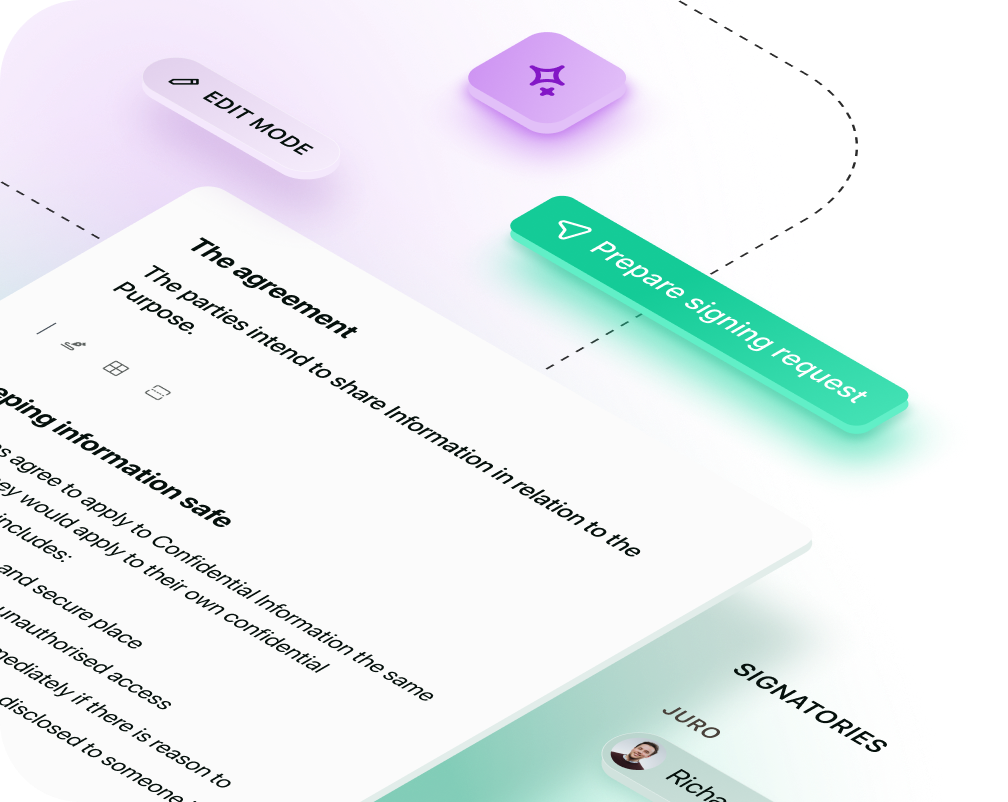Solutions
Customer Support
Resources
Minimize risk with this release of liability agreement template, ensuring parties understand the scope of responsibility and liability waivers.




In this article we explore everything you need to know about release of liability agreements – what they are, how to manage them and how Juro can help streamline the entire process.
A release of liability agreement is a legal document that transfers the responsibility of potential risks and claims from one party to another. By signing this agreement, one party agrees not to hold the other party liable for any injuries or damages that may occur during a specific activity or transaction. These agreements are essential in various business scenarios to mitigate risk and prevent litigation.
The primary purpose of a release of liability agreement is to protect businesses and individuals from potential lawsuits. It ensures that if an accident or damage occurs, the party being protected (the releasee) will not be held responsible for any claims or damages arising from the incident. This type of agreement is commonly used in activities where there is a higher risk of injury – such as sports, recreational activities and certain business operations.
Key purposes include:
Managing release of liability agreements typically involves multiple stakeholders within an organization. Legal teams are primarily responsible for drafting, reviewing and maintaining these agreements to make sure they are legally sound and comply with relevant laws. Human Resources often handles these agreements for activities involving employees, such as team-building events or workplace safety protocols. Operations managers might manage these agreements for activities that involve contractors, vendors or business partners.
Release of liability agreements are used in a variety of contexts across different industries. Some common use cases include:

A comprehensive release of liability agreement template should include the following elements:
Title. Clearly state that it is a release of liability agreement.
Parties involved. Identify the releasee (the party being protected) and the releasor (the party agreeing not to hold the releasee liable).
Description of activity. Detail the specific activity or transaction that the agreement covers.
Assumption of risk. Explicitly state that the releasor acknowledges and assumes the risks associated with the activity.
Release clause. Clearly outline that the releasor releases the releasee from any claims or liabilities.
Indemnification clause. Include a clause where the releasor agrees to indemnify the releasee for any claims arising from the activity.
Jurisdiction. Specify the legal jurisdiction under which the agreement is governed.
Signature lines. Provide space for both parties to sign and date the agreement.
Managing release of liability agreement templates typically involves the following steps:
Release of liability agreements are crucial for protecting businesses from potential legal claims. Managing these agreements can be cumbersome and time-consuming without the right tools. Juro's AI-native contract management platform streamlines this process, offering significant efficiency gains. Here’s how:
Juro enables business teams to create and manage release of liability agreements independently, without constant legal oversight. By using customizable templates, teams can quickly generate contracts tailored to specific scenarios. This reduces the bottleneck often caused by waiting for legal review and approval.
Juro’s collaborative workflows enhance the efficiency of managing release of liability agreements. Automated workflows guide users through each step of the contract lifecycle, from drafting to execution. This ensures that no steps are missed, and agreements are processed swiftly. Real-time collaboration also means that multiple stakeholders can work on the same document simultaneously – further speeding up the process.

Juro’s AI tools provide valuable insights throughout the contract lifecycle. AI can summarize key clauses, suggest improvements, and flag potential risks in release of liability agreements. This proactive approach helps to mitigate risks before they become issues, ensuring that agreements are robust and enforceable.
Juro’s integration capabilities mean that release of liability agreements can be managed within the existing tools and systems used by your teams. This seamless integration minimizes disruption and maximizes efficiency, as users do not need to switch between multiple platforms to manage contracts.
All release of liability agreements are stored in a secure, dynamic repository. This central storage not only enhances security but also provides easy access to all contracts. Users can quickly search for and retrieve specific agreements, track their status and uphold retention policies.

Juro’s platform ensures that release of liability agreements are consistently managed in accordance with legal and regulatory requirements. Automated reminders for key dates, such as renewals and expirations, help to maintain compliance and avoid potential legal issues arising from neglected contracts.
Juro’s AI-native contract automation platform transforms the way release of liability agreements are managed – empowering all teams to create, agree, execute and manage contracts up to 10x faster than traditional tools. To find out more, hit the button below to book your personalized demo.
Juro is the #1-rated contract platform globally for speed of implementation.


Juro embeds contracting in the tools business teams use every day, so they can agree and manage contracts end-to-end - while legal stays in control.
Book your demo